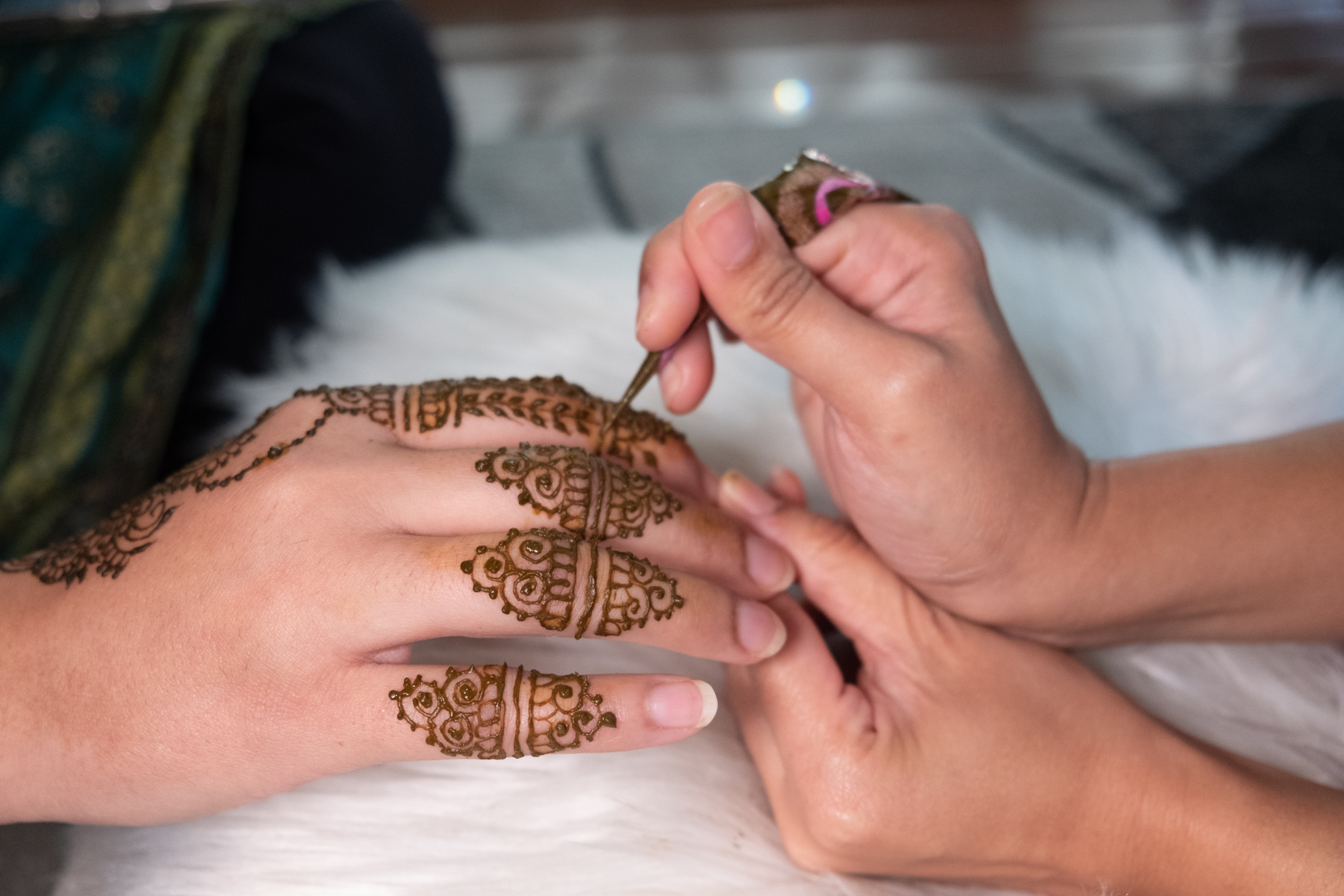Isra Irfan sat gracefully on a plush carpet in her New Jersey living room, the soft afternoon sunlight casting a warm glow over the space as her young son played nearby. Her focus was unwavering as she delicately applied henna to a client’s outstretched hand. Her fingers moved with practiced precision, the henna cone in her hand sketching the contours of intricate leaves and delicate flowers.
Henna, or mehendi, is an intricate maroon temporary tattoo created from a paste of henna leaves. Practiced by communities across South and Southwest Asia as well as West and North Africa, the designs often feature traditional visual motifs like the mandala, peacock, vines, and flowers. This art form is a crucial part of weddings and festivities, especially adorning the palms and feet.
Irfan, 28, became deeply involved in the art after moving to the United States from Pakistan in 2016. “It gives me a homey feeling in this unfamiliar city,” she told Hyperallergic.
Despite her unwavering dedication to her art, Irfan often faces a lack of recognition and respect from her clients. “People really don’t want to pay for henna. I can’t count how many times I’ve heard, ‘Well, back in my home country, henna costs this much.’ It’s exhausting,” she said. “I’ve had to specify working conditions as well. I ask for tables and chairs; otherwise, people are happy to have you work on the floor.”
Continuing to apply the labyrinthine design, Irfan added, “Henna is not considered an art. I get so many people asking for a design that would take an hour or two to be done in 15 to 30 minutes.”
Irfan isn’t alone. Many henna artists working independently in and around New York City face similar challenges. “Art cannot be timed,” said Aarti Abnave, 29, another henna artist based in the city. “People think you could just hold a cone and be done with it because they don’t want to pay as much.” For her, it’s about quality, not quantity: “I don’t just take any booking. I want to make sure my clients understand that for me to deliver outstanding results, they have to trust me.”
After years of balancing henna with a corporate job, Abnave made the leap into a full-time career two years ago. She believes henna artists are underappreciated compared to other wedding vendors. “It’s been four to five years that the prices are stuck, while other wedding vendors have raised their prices significantly,” she said.
“It’s exhausting,” said Sabeen Marghoob, another henna artist in the area, who called the simultaneous demands of creating content for social media to attract clients, managing inquiries, and dealing with last-minute cancellations a “one-person show.”
Marghoob, 29, stood surrounded by an array of ingredients in the cozy confines of her East Village apartment. She carefully measured out pure henna powder from the Indian state of Rajasthan, its deep green hue promising the rich stain cherished by so many, and added a few drops of essential oils along with water and a pinch of sugar. Her hands moved methodically, mixing the ingredients into a smooth, aromatic blend until they reached a velvety consistency, ready to be funneled into cones.


Working full-time as a financial consultant, Marghoob carves additional time for her henna business. “I loved that the art was a wearable expression of creativity that reminded me of my childhood and culture,” she said, smiling. “It always feels good to pick up a cone after a day of staring at a screen.”
Though she began doing henna as a child, Marghoob rediscovered the art form after a long hiatus and learned to make her own paste. “It wasn’t until the pandemic that I was craving a creative outlet after many years of working in the corporate world, and I had a lot of time on my hands. I picked up a cone from Curry Hill, and the rest is history. I’ve met the most wonderful people through this art and finally found an outlet I have been craving for so many years.”
Marghoob drew mainstream attention after designing henna for Oscar-winning actress Lupita Nyong’o’s head in 2023 for the premiere of Indian filmmaker Mira Nair’s musical, Monsoon Wedding. The gig helped her art gain more recognition, she explained, “but the challenges persist.”
“I do often get surprised reactions that I am so ‘passionate about my hobby’ and that it is actually a full business,” Marghoob continued. “I don’t think many people see henna as an actual art or service that is in demand or valued.”
The job’s physical demands, especially during lengthy bridal sessions that can stretch up to seven hours, are frequently underestimated. Abnave explained that many artists suffer from serious back issues, while Marghoob echoed Irfan’s experiences with impatient clients.
“Detailed henna takes more time,” she said. “I gently explain that I can’t cut the time it takes me to apply henna by half or more. Similarly, many clients want me to do 50 to 100 guests’ henna in an hour. It’s just not possible.”
Despite these challenges, henna artists are finding ways to build a more sustainable practice. Abnave plans to expand her business further by offering henna classes during the off-season, typically from November to February. Some have started to connect with each other through social media, forming networks. Abnave currently employs part-time henna artists to help her with large-scale orders. As they continue to grow their online presence, these artists are not only increasing their outreach but also fostering a stronger sense of community, ensuring that the art form is recognized and respected for the cultural significance and skill it embodies.
“My strongest moral support is all the other henna artists I’ve met in NYC, who are inspirational and supportive,” said Marghoob.



